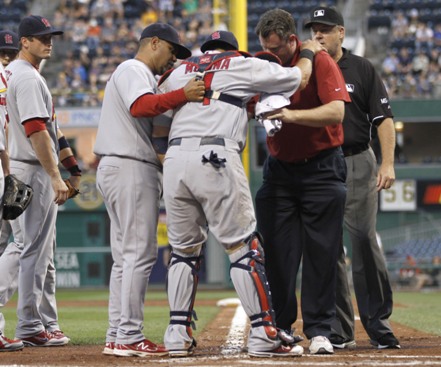
It's arguably one of the most exciting plays in baseball. A ball in play leads to a relay from the outfield and a play at the plate, with a baserunner and a baseball in an all-out race that can decide a game, a season, and sometimes, a career.
Recently, Major League Baseball has been challenged for its 'code' about home plate collisions and their necessity. The concept of baseball as a contact sport has long been debated, and recent collisions at the plate at the MLB level have some experts advocating a change in the rules.
On one hand, it's considered the 'old school' way to play the game. For example, All-Star catcher Yadier Molina of the St. Louis Cardinals was on the wrong end of a home plate collision with Pittsburgh Pirate Josh Harrison in late August. The play resulted in a woozy Molina having to leave the game with concussion-like symptoms.
When asked about it, Molina simply replied, "clean play....That's part of baseball. He did what he had to do and I did what I had to do. It (stinks) because you don't want anybody to get hurt. This time, it was me to get hurt."
Molina's words spoke undoubtedly to his toughness as a player, but a closer look at the rules questions whether he was actually in the right place at the right time. MLB Rule 7.06(b) states:
"The catcher, without the ball in his possession, has no right to block the pathway of the runner attempting to score. The base line belongs to the runner and the catcher should be there only when he is fielding a ball or when he already has the ball in his hand."
The rule certainly comes short in terms of defining what is or isn't acceptable when the ball and the runner meet the catcher at the same time, an occurrence that would make a collision at home inevitable. However, there is evidence that throughout the history of baseball, the play at the plate has not always been so eventful.
Famed baseball historian Bill James wrote in 2001 that "looking through the guides of the twenties and thirties for home-plate collisions, there aren't any that would register by modern standards. There are plenty of photographs of plays at home plate, and sometimes they run into each other, but not like now."
Not like now. Not like when Pete Rose crashed into Ray Fosse in a 1970 All-Star Game collision that Fosse with a dislocated shoulder and a lifetime full of "what-ifs" (Fosse hit .306 with a homer every 22 at-bats before 1970, and just .247 with a home run every 41 at-bats after). Not like when a 2011 collision left San Francisco Giants All-Star catcher Buster Posey with a broken leg and caused him to miss the rest of the season.
Some teams – including the Oakland Athletics and San Diego Padres- are teaching their catchers to stay away from home plate collisions if at all possible. In a recent San Diego Union-Tribune article by Bill Center, catcher John Baker explained:
"I show the runner the corner of the plate. I position myself just off the plate to force him to take that corner, putting myself in a spot where I can catch the ball and dive into the runner at the plate. He slides. I dive on top him. No one gets hurt."
"There is no way a catcher wins in those situations," added Baker, who is currently with the Atlanta Braves. "I thought after the injury to Buster Posey that something might be done. That is the only play in sports where one player with a 30-yard running head start gets to run over another player."
"Imagine if hitters were allowed to run over the first baseman on close plays at the bag. And don't tell me the catcher is protected," Baker proclaimed. "He's not...there's not that much padding, a football player is far better protected. That's a scary play. And there is too much on the line. Careers have ended or been shortened in some of those situations."
With most of amateur baseball having already outlawed any type of collision at the plate, enthusiasts wonder if it might be too much to ask Major League Baseball to do the same. When Baker was asked to give his counterparts some advice on the issue, his answer was simple:
"Avoid it at all costs."